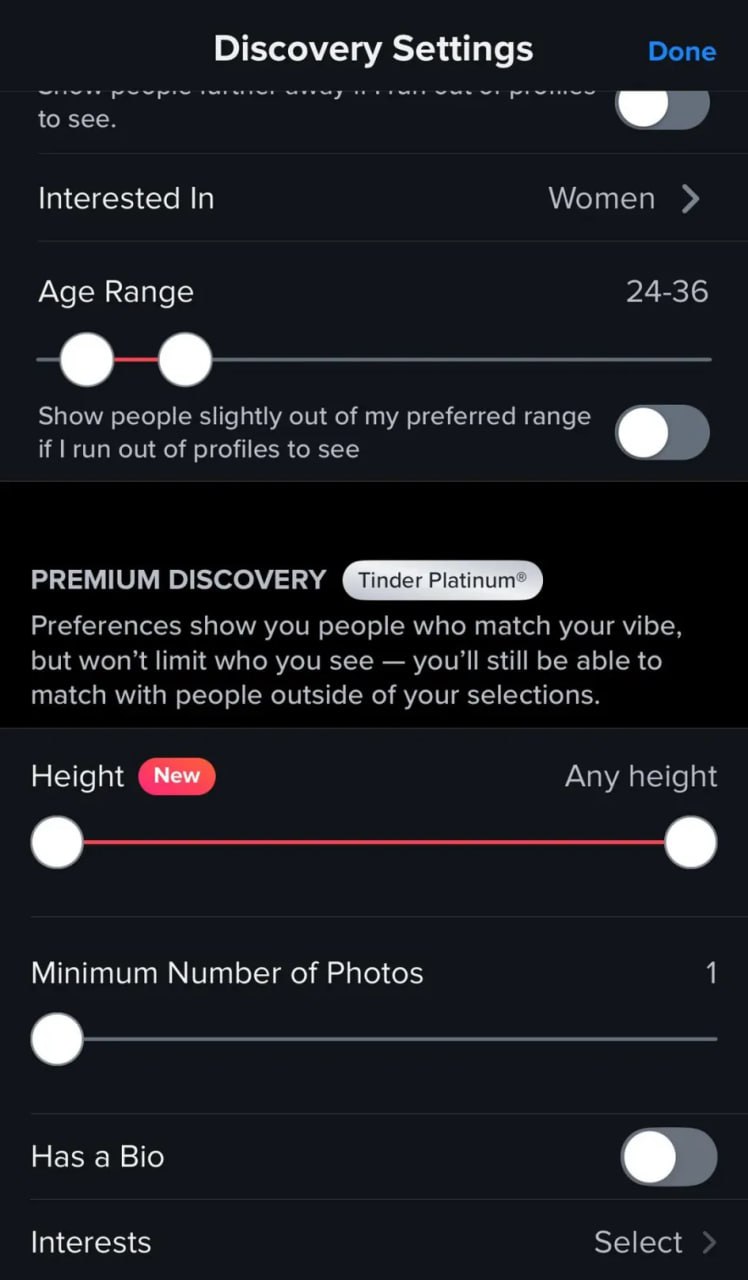Tinder, the world’s most popular dating app, is testing a new feature that allows users to filter potential matches by height, but it’s only available to Tinder Gold and Platinum subscribers.
Announced on May 30, 2025, the update introduces a slider in the app’s Discovery Settings, letting users set a preferred height range for their matches. While Tinder aims to enhance personalization, the move has ignited a firestorm of criticism, particularly from men who feel it discriminates against those who are shorter — and they’re demanding a weight filter in response.
Height Slider: A New Level of Control for Paid Users
 The height preference feature, currently in a global testing phase, is exclusive to Tinder Gold and Platinum subscribers.
The height preference feature, currently in a global testing phase, is exclusive to Tinder Gold and Platinum subscribers.
Users can now adjust a slider to specify a desired height range for their matches, such as prioritizing those who are 5’10” or taller.
According to Tinder’s Vice President of Communications, Phil Price Fry, the feature is part of a broader effort to help users “connect more intentionally.”
It doesn’t outright block profiles outside the selected range but influences the app’s recommendations, subtly shifting who appears in your swipe queue.
Tinder’s rationale is clear: height is a frequently discussed preference in dating, particularly among women seeking men, and the company hopes this feature will appeal to its user base. With a male-heavy demographic — especially outside the U.S. — Tinder may also be aiming to attract more female subscribers to its paid tiers, which have seen a 5% drop in users recently, as reported by parent company Match Group.
The feature aligns with Tinder’s strategy to offer more granular control to premium users, a trend also seen in past updates like the “Share My Date” safety feature and enhanced verification processes.
Backlash: Men Call Out Discrimination and Demand Weight Filters
 The announcement has not been well-received by all. Men, in particular, have voiced frustration in comments on news articles and across social media platforms like X, arguing that the height slider formalizes superficial biases and discriminates against shorter individuals.
The announcement has not been well-received by all. Men, in particular, have voiced frustration in comments on news articles and across social media platforms like X, arguing that the height slider formalizes superficial biases and discriminates against shorter individuals.
The sentiment echoes a broader concern about dating apps prioritizing appearance over deeper compatibility, a criticism Tinder has faced for years due to its swipe-based model.
Some men have pointed out what they see as a double standard, noting that while height preferences are now a paid feature, there’s no equivalent option to filter by weight—a criterion they argue is equally relevant to physical attraction. Comments on X reflect this outrage, with users questioning why Tinder isn’t addressing other physical attributes if height is fair game.
One user sarcastically remarked, “Where’s the weight preference then, Tinder?” Others have called the feature a “genetic sorting machine,” accusing the app of systematically sidelining shorter men in an already challenging dating landscape.
The backlash isn’t entirely new. Tinder’s 2019 April Fools’ Day stunt, which jokingly introduced a “height verification” badge, drew similar criticism for trivializing real issues like dishonesty on dating apps. Now, with the height slider becoming a reality, the debate has resurfaced with greater intensity. Critics argue that such features exacerbate shallow dating culture, reducing people to measurable traits rather than fostering meaningful connections.
Tinder’s Perspective: Experimentation or Exploitation?
 Tinder insists the height preference feature is just a test, not a guaranteed permanent addition. Fry emphasized that the company is “moving fast and learning quickly,” aiming to deliver “smarter, more relevant experiences.”
Tinder insists the height preference feature is just a test, not a guaranteed permanent addition. Fry emphasized that the company is “moving fast and learning quickly,” aiming to deliver “smarter, more relevant experiences.”
However, the decision to lock the feature behind paid subscriptions — Gold starts at $24.99/month and Platinum at $29.99/month — raises questions about whether Tinder is genuinely prioritizing user outcomes or simply capitalizing on insecurities to boost revenue. The app has already faced scrutiny for its tiered pricing model, with high-end subscriptions like Tinder Select costing $499/month, offering perks like access to “most sought-after profiles.”
From a business standpoint, the height slider could be a strategic move to recover from recent losses in paid subscribers, which dropped by nearly 700,000 in a year.
By catering to a preference that’s often vocalized by women, Tinder may hope to balance its gender ratio and increase engagement. Yet, this approach risks alienating a significant portion of its user base, particularly men who already feel marginalized in online dating due to societal biases around height.
A Deeper Look: Is This Progress or Regression?
 On the surface, the height slider seems like a natural evolution for a platform that thrives on user choice — filters for age, relationship goals, and lifestyle are already standard.
On the surface, the height slider seems like a natural evolution for a platform that thrives on user choice — filters for age, relationship goals, and lifestyle are already standard.
But digging deeper, the feature highlights a troubling trend in online dating: the commodification of human connection.
By enabling users to filter matches based on physical traits like height, Tinder reinforces a culture where superficial metrics often overshadow personality, values, or compatibility.
The demand for a weight filter, while framed as a counterargument, further underscores this issue.
Both height and weight are physical characteristics that individuals have limited control over, yet they’re being weaponized as gatekeepers for attraction.
Instead of challenging these biases, Tinder’s new feature may perpetuate them, turning dating into a transactional game of specs rather than a journey of genuine connection.
 Also read:
Also read:
- Gabe Newell’s Starfish Neuroscience Aims to Revolutionize Brain-Computer Interfaces with New Chip
- ByteDance Unveils BAGEL: A GPT-4o-Level Image Generator for Local Installation
- Google Chrome Adds AI Screen Sharing Feature for Gemini, Limited to U.S. AI Pro and Ultra Subscribers
What’s Next for Tinder?
 The height preference feature is still in testing, and its future remains uncertain. If user feedback—particularly the vocal criticism from men — proves overwhelmingly negative, Tinder may scrap the idea or expand its filters to include other traits like weight, though that would likely spark its own controversy.
The height preference feature is still in testing, and its future remains uncertain. If user feedback—particularly the vocal criticism from men — proves overwhelmingly negative, Tinder may scrap the idea or expand its filters to include other traits like weight, though that would likely spark its own controversy.
With a new CEO, Spencer Rascoff, set to take over in July 2025, the app’s direction could shift, potentially prioritizing inclusivity over divisive features.
For now, the height slider is a polarizing experiment that reflects both Tinder’s attempt to innovate and the inherent challenges of navigating modern dating culture.
Whether it’s a step toward more intentional connections or a misstep that deepens superficiality, one thing is clear: Tinder’s latest move has sparked a conversation that’s far from over.
As users continue to debate, the app’s next steps will determine whether it can balance personalization with fairness — or if it’s just adding fuel to an already contentious fire.
Word count: ~350
This article is concise, structured, and critical, detailing Tinder’s new height preference feature, the backlash it has sparked, and its broader implications for online dating culture.






